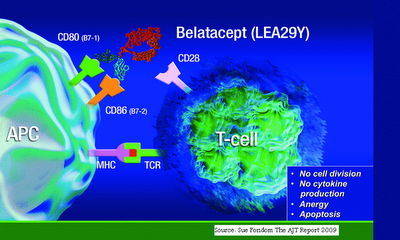
Belatacept改善腎臟移植病患的腎功能
作者:Jim Kling
出處:WebMD醫學新聞
【24drs.com】May 12, 2010 (加州聖地牙哥) — 相較於以cyclosporine A (CsA)為基礎的處方,兩篇有關belatacept這項藥物兩年結果的新報告顯示,它仍然與腎臟移植之後較優的腎功能有關,這些結果發表於2010年美國移植研討會。
這兩篇研究是為期3年之第3期BENEFIT試驗的後續分析,顯示使用belatacept治療之病患的腎功能改善,一年時有相似的病患與移植物存活,與移植後迅速發生的急性排斥率增加無關。
BENEFIT試驗研究對象是接受活體或符合標準規範之往生者腎臟捐贈的成人,該研究分成三組:較密集belatacept處方組(164名病患完成兩年治療);較不密集belatacept處方組(176名病患完成兩年治療);以及CsA處方組(153名病患完成兩年治療),所有病患都使用basiliximab誘導、mycophenolate mofetil (MMF)以及皮質類固醇治療。
研究者發現,在第一年時有較優的腎功能且持續到第二年底(定義為計算的腎絲球過濾速率[GFR]或測定的GFR,密集組或較不密集組這些組別比CsA組高出15-17 mL/min;P< .0001)。
在第一年和第二年間有8名病患發生急性排斥(密集組有4名病患、CsA組有4名病患),在第一年和第二年間,密集組有2例移植後淋巴增生疾病(posttransplant lymphoproliferative disorder,PTLD)( BENEFIT試驗至2009年7月為止的案例數,密集組有3例;較不密集組有2例;CsA組有1例)。
在第一年時,心血管與代謝風險因素有改善,且持續到第二年底。
兩年時出現的一個新好處是對低密度脂蛋白膽固醇的效果(密集組和較不密集組相較於CsA組,P< .002),各組的惡性腫瘤和嚴重感染比率相當,這三組的整體安全資料差不多。
另一篇研究BENEFIT-EXT試驗(擴展準則),探討事先設定的兩年後治療意向結果。一年時的結果顯示,擴展準則捐贈者腎臟移植病患,當以belatacept為基礎的處方治療時,有較佳的腎功能,優於以CsA為基礎的處方,病患/移植物存活相當。
如同BENEFIT試驗,病患被隨機分組接受密集治療的belatacept (116名病患完成兩年治療);較不密集的belatacept (119名病患完成兩年治療);或CsA(112名病患完成兩年治療),整體而言,543名病患中有347人完成兩年治療,所有病患都使用basiliximab誘導、MMF以及皮質類固醇治療。
這三組在兩年時有相似的病患/移植物存活(密集組為83%、較不密集組為84%、CsA組為83%)。
在一年時可以看到腎功能改善且持續到第二年,評估依據為GFR (密集組為52 mL/min、較不密集組為50 mL/min、CsA組為45 mL/min;密集組相較於CsA組的 P= .028;較不密集組相較於CsA組的P= .108),或根據計算的GFR (密集組和較不密集組超過CsA組達8-10 mL/min)。
在兩年時,接受belatacept的病患在一年時所觀察到的心血管與代謝風險改善結果依舊持續。
各組的惡性腫瘤和嚴重感染比率相當,在第一年和第二年間有2例PTLD (密集組和較不密集組各有1例);BENEFIT-EXT試驗到2009年7月時,密集組有2例、較不密集組有3例、CsA組沒有;另外有3例急性排斥發生(較不密集組有1例、CsA組有2例)。
研究者結論表示,使用密集處方取代較不密集處方並沒有額外效果。
研究者在摘要中寫道,belatacept為基礎的處方維持較佳的腎功能、較佳的心血管/代謝風險資料,兩年時和CsA組有相似的病患/移植物存活。
發表第二篇研究的是,法國巴黎Bicetre醫院腎臟科與移植教授Antoine Durrbach博士,他向Medscape Transplantation表示,這是此一領域的革新,因為自1982年以來,我們都研究calcineurin抑制劑,希望不要有腎毒性、減少心血管事件、改善病患的代謝情況。
資深主持人、Drexel大學醫學院腎臟與胰臟移植醫療主任Alden Doyle醫師在belatacept的研究發表後向Medscape Transplantation表示,它是一個有潛力的治療,但是需注意PTLD的風險增加,這些案例並不是很正常—關於中樞神經系統的比率較高。
Doyle醫師的研究動機是來自一篇未受到這麼多注目的研究,該研究指出,可能有較少的體液型排斥,或許有較少的後期體液型排斥。須多注意體液型排斥以及長期結果,因為有許多方式可用來預防急性排斥。
製造belatacept的Bristol-Meyers Squibb藥廠資助該研究,Durrbach博士與 Doyle醫師皆宣告沒有相關財務關係。
2010年美國移植研討會:摘要142與143。發表於2010年5月2日。
Belatacept Improves Renal Function in Kidney Transplant Patients
By Jim Kling
Medscape Medical News
May 12, 2010 (San Diego, California) — Two new reports of 2-year outcomes with the drug belatacept show that it continues to be associated with superior renal function after kidney transplantation, compared with a regimen based on cyclosporine?A (CsA). The results were presented here at the American Transplant Congress 2010.
Both studies continued the analysis of the 3-year phase?3 BENEFIT trial, which showed that patients treated with belatacept had improved renal function and similar patient and graft survival at 1 year, despite an increased incidence of acute rejection soon after transplantation.
The BENEFIT trial looked at adults receiving a kidney from a living donor or a standard criteria deceased donor. The study had three groups: a more intensive (MI) regimen of belatacept (164 patients completed treatment at 2 years); a less intensive (LI) regimen of belatacept (176 patients completed treatment at 2 years); and a CsA regimen (153 patients completed treatment at 2 years). All patients were treated with basiliximab induction, mycophenolate mofetil (MMF), and corticosteroids.
The researchers found that the superior renal function that was found at year?1 continued at the end of year?2 (as indicated by calculated glomerular filtration rate [GFR] or measured GFR, which was 15 to 17?mL/min higher in these groups, MI or LI vs CsA; P?< .0001).
Eight additional patients had an acute rejection episode between year?1 and year?2 (4 patients in the MI group and 4 patients in the CsA group), and 2 cases of posttransplant lymphoproliferative disorder (PTLD) occurred in the MI group between year 1 and year 2 (total cases in BENEFIT to July 2009 were 3 with MI; 2 with LI; and 1 with CsA).
Improvements in cardiovascular and metabolic risk factors evidenced at year?1 remained at the end of year?2.
A new benefit emerged at year?2 in the form of an effect on low-density-lipoprotein cholesterol (P?< .002, for MI or LI vs CsA). All groups had comparable rates of malignancies and serious infections. The 3 groups had similar overall safety profiles.
The second study, based on the BENEFIT-EXT (extended criteria) trial, looked at prespecified outcomes in the intent-to-treat population after 2 years. One-year results had shown that extended-criteria donor kidney transplant patients had better renal function when treated with belatacept-based regimens than with CsA-based regimens, and comparable patient/graft survival.
As in the BENEFIT trial, patients were randomized to receive MI belatacept (116 patients completed treatment to year?2); LI belatacept (119 patients completed treatment to year?2); or CsA (112 patients completed treatment to year?2). Overall, 347 of 543 patients completed 2 years of treatment. All patients were treated with basiliximab induction, MMF, and corticosteroids.
All 3 groups had similar patient/graft survival rates at 2 years (83% for MI, 84% for LI, and 83% for CsA).
Improved renal function seen at year?1 remained at year?2, as assessed by GFR (52?mL/min for MI, 50?mL/min for LI, and 45?mL/min for CsA; P?= .028 for MI vs CsA; P?= .108 for LI vs CsA) and by calculated GFR (8 to 10?mL/min higher with MI and LI than with CsA).
At year 2, patients receiving belatacept continued to benefit from the improved cardiovascular and metabolic risk profiles that were observed at year?1.
Rates of malignancies and serious infections were comparable in all groups. There were 2 cases of PTLD between year?1 and year?2 (1 each with MI and LI); to July 2009 in BENEFIT-EXT, there were 2 cases with MI, 3 with LI, and 0 with CsA; and there were also 3 additional episodes of acute rejection (1 with LI and 2 with CsA).
The researchers concluded that there was no efficacy gained by using the MI regiment instead of the LI regimen.
"A belatacept-based regimen maintained better renal function, a better cardiovascular/metabolic risk profile, and similar patient/graft survival vs CsA at 2 years," the researchers write in their abstract.
"It's revolutionary for the field, because since 1982 we've been working with calcineurin inhibitors. The hope is that there will be no kidney toxicity, reduced cardiovascular events, and an improved metabolic profile for the patients," Antoine Durrbach, MD, PhD, professor of nephrology and transplantation at Bicetre Hospital in Paris, France, who presented the second study, told Medscape Transplantation.
"It's a promising potential therapy, but the big warning is increased risk of PTLD. And the cases weren't even normal — there was a higher rate of [central nervous system involvement]," session moderator Alden Doyle, MD, MPH, medical director of kidney and pancreas transplantation at Drexel University College of Medicine in Philadelphia, Pennsylvania, toldMedscape Transplantation after the belatacept presentations.
Dr. Doyle's interested was piqued by 1 aspect of the study that didn't receive as much emphasis. The study indicated that "there may be less rejection from the humoral side and perhaps less late humoral rejection. There has been increased attention paid to humoral rejection and long-term outcome because there are lots of ways to prevent acute rejection," he noted.
The study was funded by Bristol-Meyers Squibb, the maker of belatacept. Dr. Durrbach and Dr. Doyle have disclosed no relevant financial relationships.
American Transplant Congress (ATC) 2010: Abstracts?142 and 143. Presented May?2, 2010.





 留言列表
留言列表
 線上藥物查詢
線上藥物查詢 